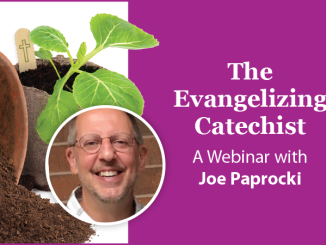
As we continue our summer series, Preparing Hearts and Minds: 9 Simple Ways for Catechists to Cultivate a Living Faith, we come to strategy #6.
Strategy #6: Invite, invite, invite!
Ultimately, an advertisement is an invitation; after presenting all the information about their amazing product or service, the sponsors invite potential customers to join “other satisfied customers.” They then provide a phone number, a website address, and convenient locations so that potential customers can avoid being left out. In a similar manner, an effective website or marketing e-mail always includes what is referred to as a CTA—a “call to action,” which usually takes the form of a button or hyperlinked line of text that invites us to “learn more,” “buy now,” “get 50% off now,” or “download now.”
In a general sense, our catechesis is an invitation to follow Jesus. However, evangelizing catechists take it a step further and issue a call to action: specific invitations for those they teach to deepen their commitment to Christ. Some examples might include invitations to:
- Participate in a retreat experience.
- Engage in service and works of mercy.
- Collaborate on a project.
- Participate in a liturgical ministry such as lector, altar server, cantor, greeter, or extraordinary minister of Holy Communion.
- Join a faith-sharing or Bible-study group.
- Become a leader of a small group or serve as an aide.
- Attend a workshop, seminar, rally, or conference to hear an inspirational speaker.
Invitations to new experiences serve to loosen the soil of people’s lives, helping them to get out of the rut of compacted soil that is holding them back.
In years gone by, the priests and nuns who staffed most faith formation programs and taught in Catholic schools recognized that it was their job to invite young people to respond to the call to live out their Baptism and, perhaps, to consider priesthood or religious life. Now, as the lay majority who staff faith formation programs most everywhere, it’s our turn to pick up this task. As catechists and teachers, we need to be on the lookout for opportunities to invite young people to use their gifts to serve others and, in doing so, to encounter Christ and to experience a better way of being human. If we want to loosen the soil of people’s hearts and minds, we need to invite, invite, invite!
When extending an invitation to anyone—especially young people—be sure that the invitation:
- is for more than one person so that one individual is not being singled out.
- is approved by a pastoral staff member, usually the catechetical leader.
- is issued on behalf of yourself and some other pastoral staff member.
- is communicated to the parents of young people and requires their permission.
- includes details and facts about the nature of the experience and safeguards that will be in place for young people.
- indicates to whom questions may be directed.
- spells out other adults who will be present to supervise.
- provides the invitee with a true choice/an easy out if they prefer not to accept.
- follows all parish and diocesan policies.
Personal invitations can change lives, because they can change the way we think and feel about ourselves and others. This means that they serve as a critical tool in the process of conversion, which is the call to change how we think, feel, and act. Personal invitations create an emotional connection, which is a critical part of the whole process. It’s one thing to read an announcement or receive a flier inviting us to an event. It is quite another thing to have someone tap us on the shoulder and personally invite us to an event or experience.
In the end, extending personal invitations says a lot about the inviter. To invite is to create an atmosphere of welcome. That can go a long way toward a person eventually accepting an invitation, even if one is not ready to accept in the present. It may also lead a person to redirect the invitation to another person who might be more inclined to respond affirmatively at the present time. Like John the Baptist, we must be the ones who say to others, “Look, the Lamb of God!” (John 1:29) Invitation is at the heart of learning. We can have all the most wonderful designs, delivery systems, and assessments, but it is the power of the invitation to learn that makes all the difference—and provides just one more reason why no video or online resource can ever take the place of the person of the catechist, who alone can communicate a personal invitation.
* * *
Be sure to check out my new book, Preparing Hearts and Minds: 9 Simple Ways for Catechists to Cultivate a Living Faith.





Be the first to comment